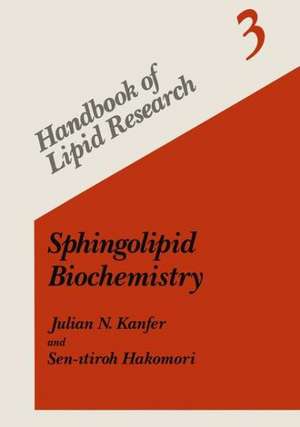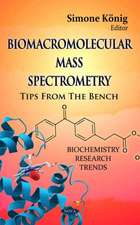Sphingolipid Biochemistry: Handbook of Lipid Research, cartea 3
Autor Julian N. Kanfer, Sen-itiroh Hakomorien Limba Engleză Paperback – 18 mai 2012
Preț: 406.80 lei
Nou
Puncte Express: 610
Preț estimativ în valută:
77.84€ • 81.49$ • 64.41£
77.84€ • 81.49$ • 64.41£
Carte tipărită la comandă
Livrare economică 07-21 aprilie
Preluare comenzi: 021 569.72.76
Specificații
ISBN-13: 9781475703986
ISBN-10: 1475703988
Pagini: 500
Ilustrații: 485 p. 124 illus.
Dimensiuni: 178 x 254 x 26 mm
Greutate: 0.86 kg
Ediția:Softcover reprint of the original 1st ed. 1983
Editura: Springer Us
Colecția Springer
Seria Handbook of Lipid Research
Locul publicării:New York, NY, United States
ISBN-10: 1475703988
Pagini: 500
Ilustrații: 485 p. 124 illus.
Dimensiuni: 178 x 254 x 26 mm
Greutate: 0.86 kg
Ediția:Softcover reprint of the original 1st ed. 1983
Editura: Springer Us
Colecția Springer
Seria Handbook of Lipid Research
Locul publicării:New York, NY, United States
Public țintă
ResearchCuprins
1 Chemistry of Glycosphingolipids.- 1.1. Introduction.- 1.2. Isolation of Glycosphingolipids.- 1.3. Characterization of Glycosphingolipids.- 1.4. Structure of Glycosphingolipids.- 1.5. Chemical Synthesis and Modification of Sphingosines and Glycosphingolipids.- 1.6. Pioneers in Glycolipid Chemistry.- 1.7. References.- 2 Sphingolipid Metabolism.- 2.1. Sphingosine Bases.- 2.2. The Psychosines.- 2.3. Ceramide (N-Acylsphingosine).- 2.4. Galactosylceramide.- 2.5. Ceramide-galactoside-3-sulfate (Sulfatide).- 2.6. Glucosylceramide.- 2.7. Ganglioside Metabolism.- 2.8. Sphingomyelin.- 2.9. Biosynthesis of the Sphingolipids: Summary.- 3 The Sphingolipidoses.- 3.1. Farber’s Lipogranulomatosis.- 3.2. Krabbe’s Disease (Globoid Cell Leukodystrophy).- 3.3. Metachromatic Leukodystrophy.- 3.4. Gaucher’s Disease.- 3.5. Fabry’s Disease (Angiokeratoma Corporis Diffusium).- 3.6. The Gangliosidoses.- 3.7. Niemann-Pick’s Disease.- 3.8. GM3 Gangliosidosis.- 3.9. General Comments.- 3.10. References.- 4 Glycosphingolipids in Cellular Interaction, Differentiation, and Oncogenesis.- 4.1. Introduction.- 4.2. Organization and Dynamic State of Glycohpids in Membranes.- 4.3. Glycolipids in Cellular Interaction and Differentiation.- 4.4. Role of Glycolipids in Cell Growth Control.- 4.5. Glycolipid Changes in Oncogenic Transformation: Deficiency in Glycolipid Function.- 4.6. Glycolipids as Possible Mediators of Immune Response.- 4.7. Postscript: Enigmas Concerning Glycohpid Functions.- 4.8. References.- 5 Glycolipid Antigens and Genetic Markers.- 5.1. Introduction.- 5.2. General Properties of Glycolipid Antigens.- 5.3. Heterophil Antigens.- 5.4. Glycolipids with Blood Group AB H Specificities.- 5.5. Glycolipids with Blood Group Lewis (Lea, Leb, Lec and Led) Specificities.- 5.6. Glycolipidswith Blood Group P, P1, and Pk Specificities.- 5.7. Glycolipids with Blood Group I and i Specificities.- 5.8. Glycolipids with Blood Group J-Antigen Specificity.- 5.9. Tissue-Specific and Tumor-Associated Glycolipid Antigens.- 5.10. Modification of Blood Group Antigens.- 5.11. Tissue-Specific or Organ-Specific Glycolipid Antigens.- 5.12. Glycolipid Antigens Associated with Autoimmune Processes.- 5.13. References.- 6 Glycosphingolipids as Receptors.- 6.1. Gangliosides and the Serotonin Receptor.- 6.2. Gangliosides and Acetylcholine.- 6.3. Gangliosides and Interferon.- 6.4. Gangliosides and Bacterial Toxins.- 6.5. Gangliosides and Lymphocyte Markers.- 6.6. Gangliosides and Glycoprotein Hormone Receptors.- 6.7. Conclusions.- 6.8. References.

















